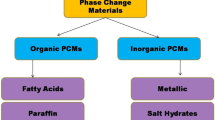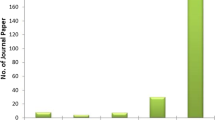Abstract
Solar absorption cooling is a wonderful method to provide cold energy by exploiting solar energy. Phase change materials (PCMs) that store latent thermal energy are indispensible in solar absorption cooling system. It is worthwhile to find new PCMs due to the demanding on the temperature of the stored thermal energy which in turn would power the absorption chiller. In this paper, two compounds: 1-bromo-2-methoxynaphthalene (compound 1) and 2,2′-diphenyl-4,4′-bi(1,3-dioxane)-5,5′-diol (compound 2), were selected as potential PCMs. Their thermal energy storage properties and thermal stability were characterized by differential scanning calorimetry and thermogravimetric analysis. The results showed that both compounds could be applied as good PCMs in solar absorption cooling systems. Compound 1 melted at 356.82 K with the ΔH of 98.81 J g−1, while compound 2 melted in a broad temperature range with the melting point of 466.26 K and the ΔH of 101.4 J g−1. Both compounds exhibited good thermal stability. Furthermore, the molar specific heat capacities of these two compounds were measured by temperature-modulated differential scanning calorimetry from 198.15 K to the temperature that they started to decompose, and the thermodynamic functions of [H T–H 298.15] and [S T–S 298.15] were calculated based on the specific heat capacities data.







Similar content being viewed by others
References
Li C, Shi H, Cao Y, Wang J, Kuang Y, Tan Y, et al. Comprehensive review of renewable energy curtailment and avoidance: a specific example in China. Renew Sustain Energy Rev. 2015;41:1067–79. doi:10.1016/j.rser.2014.09.009.
Elser M, Huang RJ, Wolf R, Slowik JG, Wang Q, Canonaco F, et al. New insights into PM2.5 chemical composition and sources in two major cities in China during extreme haze events using aerosol mass spectrometry. Atmos Chem Phys. 2016;16(5):3207–25. doi:10.5194/acp-16-3207-2016.
Aman MM, Solangi KH, Hossain MS, Badarudin A, Jasmon GB, Mokhlis H, et al. A review of Safety, Health and Environmental (SHE) issues of solar energy system. Renew Sustain Energy Rev. 2015;41:1190–204. doi:10.1016/j.rser.2014.08.086.
Crabtree GW, Lewis NS. Solar energy conversion. Phys Today. 2007;60(3):37–42.
Zalba B, Marin JM, Cabeza LF, Mehling H. Review on thermal energy storage with phase change: materials, heat transfer analysis and applications. Appl Therm Eng. 2003;23(3):251–83.
Farid MM, Khudhair AM, Razack SAK, Al-Hallaj S. A review on phase change energy storage: materials and applications. Energy Convers Manag. 2004;45(9–10):1597–615.
Nithyanandam K, Pitchumani R. Cost and performance analysis of concentrating solar power systems with integrated latent thermal energy storage. Energy. 2014;64:793–810. doi:10.1016/j.energy.2013.10.095.
Zhang H, Xu Q, Zhao Z, Zhang J, Sun Y, Sun L, et al. Preparation and thermal performance of gypsum boards incorporated with microencapsulated phase change materials for thermal regulation. Sol Energy Mater Sol Cells. 2012;102:93–102. doi:10.1016/j.solmat.2012.03.020.
Zeng JL, Zheng SH, Yu SB, Zhu FR, Gan J, Zhu L, et al. Preparation and thermal properties of palmitic acid/polyaniline/exfoliated graphite nanoplatelets form-stable phase change materials. Appl Energy. 2014;115:603–9. doi:10.1016/j.apenergy.2013.10.061.
Zeng JL, Gan J, Zhu FR, Yu SB, Xiao ZL, Yan WP, et al. Tetradecanol/expanded graphite composite form-stable phase change material for thermal energy storage. Sol Energy Mater Sol Cells. 2014;127:122–8. doi:10.1016/j.solmat.2014.04.015.
Karaipekli A, Sarı A. Development and thermal performance of pumice/organic PCM/gypsum composite plasters for thermal energy storage in buildings. Sol Energy Mater Sol Cells. 2016;149:19–28. doi:10.1016/j.solmat.2015.12.034.
Kheradmand M, Azenha M, de Aguiar JLB, Castro-Gomes J. Experimental and numerical studies of hybrid PCM embedded in plastering mortar for enhanced thermal behaviour of buildings. Energy. 2016;94:250–61. doi:10.1016/j.energy.2015.10.131.
Roman KK, O’Brien T, Alvey JB, Woo O. Simulating the effects of cool roof and PCM (phase change materials) based roof to mitigate UHI (urban heat island) in prominent US cities. Energy. 2016;96:103–17. doi:10.1016/j.energy.2015.11.082.
Pintaldi S, Perfumo C, Sethuvenkatraman S, White S, Rosengarten G. A review of thermal energy storage technologies and control approaches for solar cooling. Renew Sustain Energy Rev. 2015;41:975–95. doi:10.1016/j.rser.2014.08.062.
Shkatulov A, Ryu J, Kato Y, Aristov Y. Composite material “Mg(OH)2/vermiculite”: a promising new candidate for storage of middle temperature heat. Energy. 2012;44(1):1028–34. doi:10.1016/j.energy.2012.04.045.
Lv Y, Zhou W, Yang Z, Jin W. Characterization and numerical simulation on heat transfer performance of inorganic phase change thermal storage devices. Appl Therm Eng. 2016;93:788–96. doi:10.1016/j.applthermaleng.2015.10.058.
Seo J, Shin D. Size effect of nanoparticle on specific heat in a ternary nitrate (LiNO3–NaNO3–KNO3) salt eutectic for thermal energy storage. Appl Therm Eng. 2016;102:144–8. doi:10.1016/j.applthermaleng.2016.03.134.
Zhao CY, Ji Y, Xu Z. Investigation of the Ca(NO3)2–NaNO3 mixture for latent heat storage. Sol Energy Mater Sol Cells. 2015;140:281–8. doi:10.1016/j.solmat.2015.04.005.
Gunasekara SN, Pan R, Chiu JN, Martin V. Polyols as phase change materials for surplus thermal energy storage. Appl Energy. 2016;162:1439–52. doi:10.1016/j.apenergy.2015.03.064.
Zhang X, Chen X, Han Z, Xu W. Study on phase change interface for erythritol with nano-copper in spherical container during heat transport. Int J Heat Mass Tranf. 2016;92:490–6. doi:10.1016/j.ijheatmasstransfer.2015.08.095.
Kholmanov I, Kim J, Ou E, Ruoff RS, Shi L. Continuous carbon nanotube-ultrathin graphite hybrid foams for increased thermal conductivity and suppressed subcooling in composite phase change materials. ACS Nano. 2015;9(12):11699–707. doi:10.1021/acsnano.5b02917.
Xiao Z-K, Yin H-Y, Lu J-M. N-Heterocyclic carbene-palladium(II)-1-methylimidazole complex catalyzed α-arylation of symmetric dialkyl ketones with aryl chlorides. Inorg Chim Acta. 2014;423:106–8. doi:10.1016/j.ica.2014.07.061.
Hosoi S, Ozeki M, Nakano M, Arimitsu K, Kajimoto T, Kojima N, et al. Mechanistic aspects of asymmetric intramolecular Heck reaction involving dynamic kinetic resolution: flexible conformation of the cyclohexenylidene–benzene system. Tetrahedron. 2015;71(15):2317–26. doi:10.1016/j.tet.2015.01.020.
Karki M, Magolan J. Bromination of olefins with HBr and DMSO. J Org Chem. 2015;80(7):3701–7. doi:10.1021/acs.joc.5b00211.
Al-Majid AMA, Barakat A, Mabkhot YN, Islam MS. Synthesis and characterization of privileged monodentate phosphoramidite ligands and chiral Brønsted acids derived from D-Mannitol. Int J Mol Sci. 2012;13(3):2727.
D-f Lu, Y-y Di, J-m Dou. Crystal structures and solid–solid phase transitions on phase change materials (1 − CnH2n + 1NH3)2CuCl4(s) (n = 10 and 11). Sol Energy Mater Sol Cells. 2013;114:1–8. doi:10.1016/j.solmat.2013.02.009.
Wunderlich B, Jin Y, Boller A. Mathematical description of differential scanning calorimetry based on periodic temperature modulation. Thermochim Acta. 1994;238:277–93. doi:10.1016/S0040-6031(94)85214-6.
Danley RL. New modulated DSC measurement technique. Thermochim Acta. 2003;402(1–2):91–8. doi:10.1016/S0040-6031(02)00541-5.
Rivière L, Caussé N, Lonjon A, Dantras É, Lacabanne C. Specific heat capacity and thermal conductivity of PEEK/Ag nanoparticles composites determined by Modulated-Temperature Differential Scanning Calorimetry. Polym Degrad Stab. 2016;127:98–104. doi:10.1016/j.polymdegradstab.2015.11.015.
Qiu S, Chu H, Zou Y, Xiang C, Zhang H, Sun L, et al. Thermochemical studies of Rhodamine B and Rhodamine 6G by modulated differential scanning calorimetry and thermogravimetric analysis. J Therm Anal Calorim. 2015;123(2):1611–8. doi:10.1007/s10973-015-5055-5.
Archer DG. Thermodynamic properties of synthetic sapphire (α-Al2O3), standard reference material 720 and the effect of temperature-scale differences on thermodynamic properties. J Phys Chem Ref Data. 1993;22(6):1441–53. doi:10.1063/1.555931.
Ginnings DC, Furukawa GT. Heat capacity standards for the range 14 to 1200 °K. J Am Chem Soc. 1953;75(3):522–7. doi:10.1021/ja01099a004.
Baggett N, Stribblehill P. Asymmetric reduction of ketones by using complexes of lithium tetrahydridoaluminate(III) with 1,4:3,6-dianhydro-D-mannitol and 1,3:4,6-di-O-benzylidene-D-mannitol. J Chem Soc Perkin Trans. 1977;1(10):1123–6. doi:10.1039/p19770001123.
Zeng JL, Yu SB, Cao Z, Yang DW, Sun LX, Zhang L, et al. Synthesize, crystal structure, heat capacities and thermodynamic properties of a potential enantioselective catalyst. J Therm Anal Calorim. 2011;105(3):961–8. doi:10.1007/s10973-011-1486-9.
Song L-F, Jiang C-H, Zhang J, Sun L-X, Xu F, You W-S, et al. Heat capacities and thermodynamic properties of a novel mixed-ligands MOFs. J Therm Anal Calorim. 2009;100(2):679–84. doi:10.1007/s10973-009-0207-0.
Zhang XF, Wang SF, Wu ZS. Physical chemistry. Wuhan: Huazhong University of Science & Technology Press; 2012.
Acknowledgements
This work was supported by the National Natural Science Foundation of China (21003014, 21501015, 21275022), the Natural Science Foundation of Hunan Province, China (13JJ3068), the Scientific Research Fund of Hunan Provincial Education Department (15B0002) and the Hunan Provincial Key Laboratory of Materials Protection for Electric Power and Transportation (Changsha University of Science & Technology) (2014CL05).
Author information
Authors and Affiliations
Corresponding author
Rights and permissions
About this article
Cite this article
Yu, SB., Zeng, JL., Sun, SL. et al. Thermal properties characterization of two promising phase change material candidates. J Therm Anal Calorim 129, 189–199 (2017). https://doi.org/10.1007/s10973-017-6152-4
Received:
Accepted:
Published:
Issue Date:
DOI: https://doi.org/10.1007/s10973-017-6152-4




